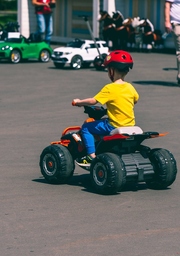The Influence of Electric Car Play on Kids’ Imagination and Resilience
Electric cars have been gaining popularity in recent years, and it’s not just adults who are fascinated by these eco-friendly vehicles. Children are also captivated by the sleek design and futuristic technology of electric cars. But beyond just being a cool mode of transportation, electric cars can actually have a positive impact on kids’ imagination and resilience.
In this blog post, we’ll explore how playing with electric cars can spark creativity and build resilience in children. So, whether you’re a parent looking for a new toy for your child or an educator seeking to incorporate electric cars into the classroom, keep reading to discover the potential benefits of this type of play. Let’s get started.
Promotes Problem-Solving Skills
Playing with electric cars requires children to think critically and problem-solve. As highlighted by the team behind Kidaroos, there are different types of electric cars that have various features and functions. With these features, children are able to explore and experiment with different scenarios, such as navigating through obstacles or figuring out how to charge the car.
As they encounter challenges while playing, they develop problem-solving skills and learn to think outside the box in order to overcome these obstacles. For example, they may need to troubleshoot why one car is not moving or find a way to maneuver around obstacles while driving.
These problem-solving skills are crucial for children’s cognitive development and can be applied to real-life situations in the future. Electric car play offers a fun and engaging way for children to enhance their problem-solving abilities while having fun.
Encourages Imagination and Creativity
Electric cars are a blank canvas for children’s imagination to run wild. They can create imaginary scenarios and storylines as they play with their cars, incorporating other toys and elements to make the game more exciting. This type of open-ended play encourages children to think creatively and use their imagination without any limitations.
Moreover, as electric cars are still a relatively new concept for many children, they can also come up with unique ideas on how these vehicles can look and function in the future. It sparks curiosity and encourages children to think outside the box, ultimately fostering their creativity.
Introduces Sustainable Technology
With the growing concern for the environment, it’s essential to educate children about sustainable practices from a young age. Electric cars offer a perfect opportunity to introduce this concept in a fun and engaging way.
Through play, children can learn about clean energy and how electric cars are a more eco-friendly alternative to traditional gas-powered vehicles. They can also understand the importance of reducing carbon emissions and taking care of the planet. By incorporating this knowledge early on, children can develop a sense of responsibility for the environment and make informed decisions in the future.
Enhances Fine Motor Skills
Playing with small electric cars requires children to use their fine motor skills, developing hand-eye coordination and dexterity. As they maneuver the cars around and operate the different features, they’re strengthening their fingers and hands’ muscles. This is crucial for children’s overall development, as these skills are necessary for everyday tasks such as writing and drawing.
Moreover, electric car play can also involve assembling or building the cars themselves, which further enhances fine motor skills and introduces children to basic engineering concepts. It’s a fun and hands-on way for children to improve their fine motor abilities while having a blast.
Develops Spatial Awareness

Driving electric cars around obstacles or through specific paths requires children to have a sense of spatial awareness. They need to understand the car’s position and how much space it has to maneuver through different environments. This can improve their spatial reasoning skills, which are essential for tasks like reading maps or following directions.
Furthermore, electric car play can also involve setting up mini-cities or landscapes for the cars to drive around in, which further enhances children’s understanding of space and perspective. It’s a fun and interactive way for children to develop crucial spatial awareness skills while playing with their electric cars.
Fosters Cooperative Play and Communication
Electric car play can also be a social activity, encouraging children to interact and communicate with one another. They can take turns driving the cars or work together to create imaginative scenarios. This type of cooperative play fosters essential social skills in children, such as sharing, taking turns, and communicating effectively.
Moreover, as electric car play involves problem-solving and creativity, children may need to work together to come up with solutions or ideas, promoting teamwork and collaboration. It’s a fantastic opportunity for children to develop their social skills while having fun with their friends.
Builds Resilience through Trial and Error
Playing with electric cars can also teach children resilience, as they encounter challenges and obstacles while driving. They may need to try different strategies or approaches to overcome these challenges, learning through trial and error. This process can build resilience in children as they learn that it’s okay to make mistakes and keep trying until they succeed.
Moreover, electric car play also introduces the concept of failure not being permanent but rather a stepping stone towards success. It encourages children to persevere and not give up when faced with difficulties, which is a crucial skill in developing resilience.
Teaches Responsibility for the Environment
Electric car play can also instill a sense of responsibility for the environment in children. As they learn about clean energy and sustainability through play, they can understand how their actions impact the planet. This can promote environmentally friendly habits and choices in children, such as turning off lights or conserving water.
Moreover, electric car play can also involve teaching children how to take care of their toys properly and recycle any parts or materials when they’re no longer usable. It’s a great way for children to learn about being responsible for their actions and making a positive impact on the environment.
Electric car play has many benefits for children, beyond just providing entertainment. From enhancing problem-solving skills to fostering imagination and creativity, this type of play can have a significant impact on a child’s development. It also introduces important concepts such as sustainable technology, fine motor skills, spatial awareness, cooperative play and communication, resilience, and responsibility for the environment. So, consider incorporating electric car play into your child’s or classroom’s activities to reap these benefits and have fun while doing so!







